Detailed Accounting Report: Sparks Company Financial Statements Review
VerifiedAdded on 2020/07/23
|11
|3377
|57
Report
AI Summary
This report presents an analysis of Sparks Company's financial activities for the year ending September 30, 2017. It begins with an overview of the company's transactions, including sales, purchases, expenses, and other key financial events. The report then delves into various record-keeping systems used by accountants, such as day books, general ledgers, and the double-entry system, explaining their significance in maintaining accurate financial records. Furthermore, it explores the trial balance and the preparation of annual reports. The report concludes with a detailed explanation of the accruals concept, providing illustrative examples to enhance understanding. The analysis covers the company's financial performance, emphasizing key metrics such as gross profit and net income, and highlights areas for potential improvement in financial strategies. The report is a comprehensive review of Sparks Company's accounting practices, offering insights into its financial health and operational efficiency.

ACCOUNTING
Paraphrase This Document
Need a fresh take? Get an instant paraphrase of this document with our AI Paraphraser
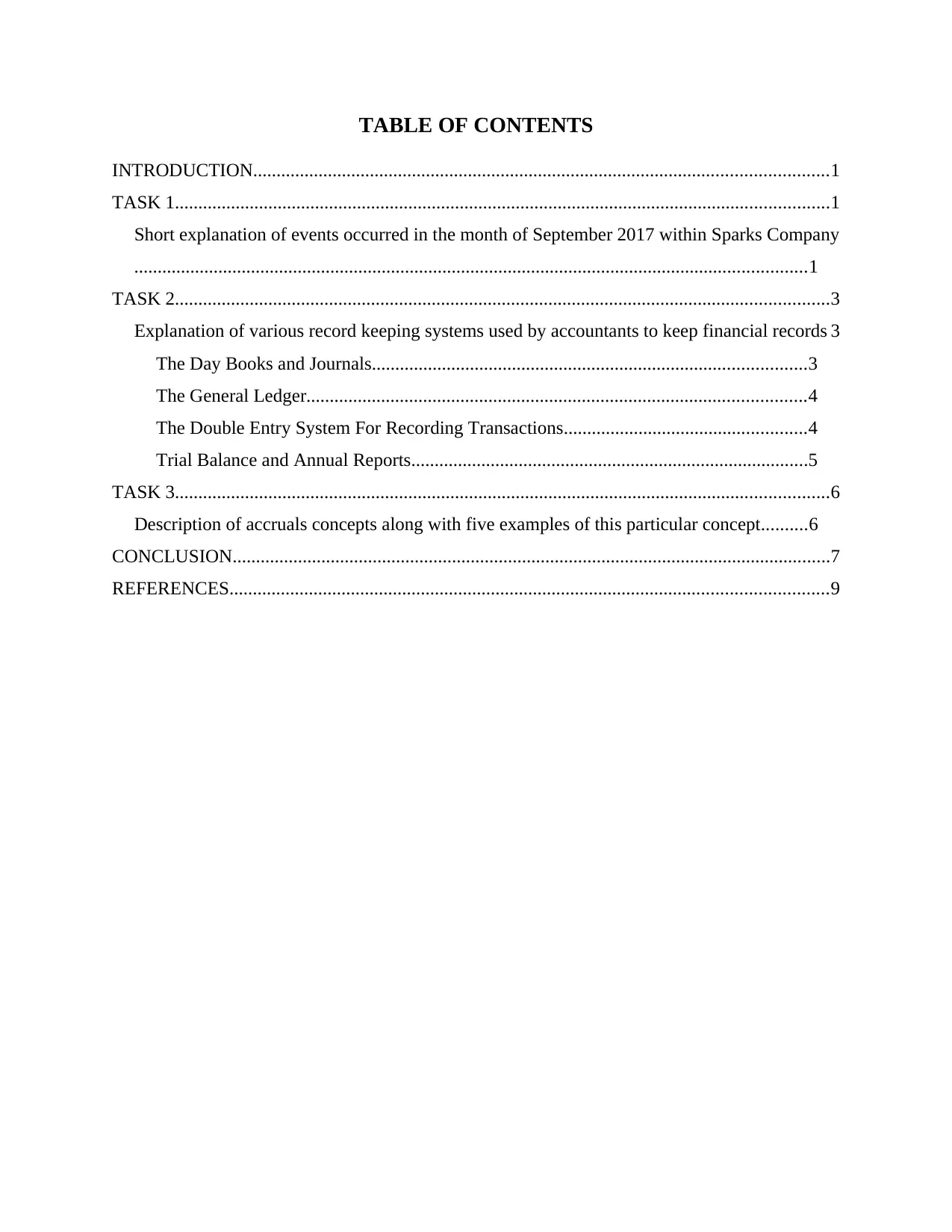
TABLE OF CONTENTS
INTRODUCTION...........................................................................................................................1
TASK 1............................................................................................................................................1
Short explanation of events occurred in the month of September 2017 within Sparks Company
................................................................................................................................................1
TASK 2............................................................................................................................................3
Explanation of various record keeping systems used by accountants to keep financial records 3
The Day Books and Journals.............................................................................................3
The General Ledger...........................................................................................................4
The Double Entry System For Recording Transactions....................................................4
Trial Balance and Annual Reports.....................................................................................5
TASK 3............................................................................................................................................6
Description of accruals concepts along with five examples of this particular concept..........6
CONCLUSION................................................................................................................................7
REFERENCES................................................................................................................................9
INTRODUCTION...........................................................................................................................1
TASK 1............................................................................................................................................1
Short explanation of events occurred in the month of September 2017 within Sparks Company
................................................................................................................................................1
TASK 2............................................................................................................................................3
Explanation of various record keeping systems used by accountants to keep financial records 3
The Day Books and Journals.............................................................................................3
The General Ledger...........................................................................................................4
The Double Entry System For Recording Transactions....................................................4
Trial Balance and Annual Reports.....................................................................................5
TASK 3............................................................................................................................................6
Description of accruals concepts along with five examples of this particular concept..........6
CONCLUSION................................................................................................................................7
REFERENCES................................................................................................................................9
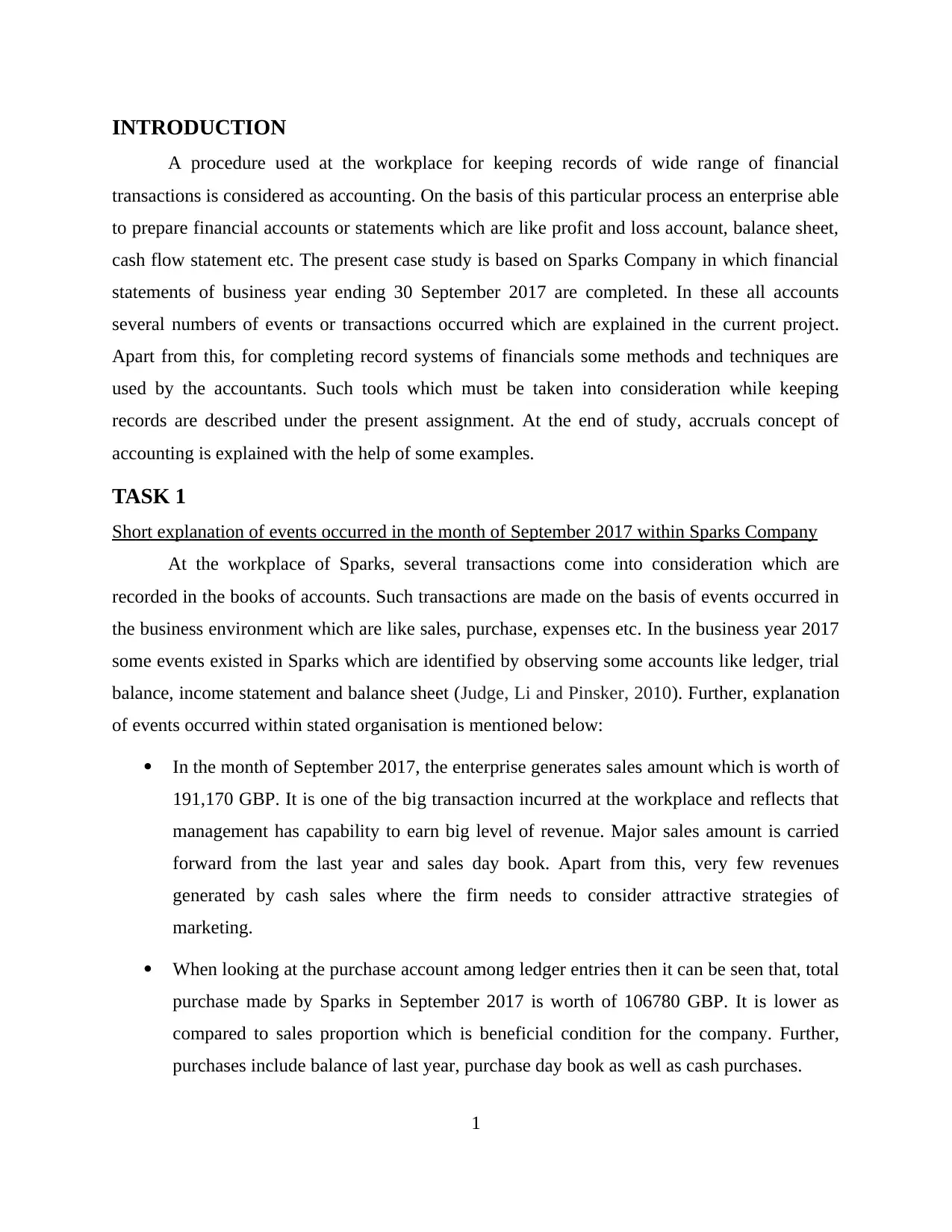
INTRODUCTION
A procedure used at the workplace for keeping records of wide range of financial
transactions is considered as accounting. On the basis of this particular process an enterprise able
to prepare financial accounts or statements which are like profit and loss account, balance sheet,
cash flow statement etc. The present case study is based on Sparks Company in which financial
statements of business year ending 30 September 2017 are completed. In these all accounts
several numbers of events or transactions occurred which are explained in the current project.
Apart from this, for completing record systems of financials some methods and techniques are
used by the accountants. Such tools which must be taken into consideration while keeping
records are described under the present assignment. At the end of study, accruals concept of
accounting is explained with the help of some examples.
TASK 1
Short explanation of events occurred in the month of September 2017 within Sparks Company
At the workplace of Sparks, several transactions come into consideration which are
recorded in the books of accounts. Such transactions are made on the basis of events occurred in
the business environment which are like sales, purchase, expenses etc. In the business year 2017
some events existed in Sparks which are identified by observing some accounts like ledger, trial
balance, income statement and balance sheet (Judge, Li and Pinsker, 2010). Further, explanation
of events occurred within stated organisation is mentioned below:
In the month of September 2017, the enterprise generates sales amount which is worth of
191,170 GBP. It is one of the big transaction incurred at the workplace and reflects that
management has capability to earn big level of revenue. Major sales amount is carried
forward from the last year and sales day book. Apart from this, very few revenues
generated by cash sales where the firm needs to consider attractive strategies of
marketing.
When looking at the purchase account among ledger entries then it can be seen that, total
purchase made by Sparks in September 2017 is worth of 106780 GBP. It is lower as
compared to sales proportion which is beneficial condition for the company. Further,
purchases include balance of last year, purchase day book as well as cash purchases.
1
A procedure used at the workplace for keeping records of wide range of financial
transactions is considered as accounting. On the basis of this particular process an enterprise able
to prepare financial accounts or statements which are like profit and loss account, balance sheet,
cash flow statement etc. The present case study is based on Sparks Company in which financial
statements of business year ending 30 September 2017 are completed. In these all accounts
several numbers of events or transactions occurred which are explained in the current project.
Apart from this, for completing record systems of financials some methods and techniques are
used by the accountants. Such tools which must be taken into consideration while keeping
records are described under the present assignment. At the end of study, accruals concept of
accounting is explained with the help of some examples.
TASK 1
Short explanation of events occurred in the month of September 2017 within Sparks Company
At the workplace of Sparks, several transactions come into consideration which are
recorded in the books of accounts. Such transactions are made on the basis of events occurred in
the business environment which are like sales, purchase, expenses etc. In the business year 2017
some events existed in Sparks which are identified by observing some accounts like ledger, trial
balance, income statement and balance sheet (Judge, Li and Pinsker, 2010). Further, explanation
of events occurred within stated organisation is mentioned below:
In the month of September 2017, the enterprise generates sales amount which is worth of
191,170 GBP. It is one of the big transaction incurred at the workplace and reflects that
management has capability to earn big level of revenue. Major sales amount is carried
forward from the last year and sales day book. Apart from this, very few revenues
generated by cash sales where the firm needs to consider attractive strategies of
marketing.
When looking at the purchase account among ledger entries then it can be seen that, total
purchase made by Sparks in September 2017 is worth of 106780 GBP. It is lower as
compared to sales proportion which is beneficial condition for the company. Further,
purchases include balance of last year, purchase day book as well as cash purchases.
1
⊘ This is a preview!⊘
Do you want full access?
Subscribe today to unlock all pages.

Trusted by 1+ million students worldwide
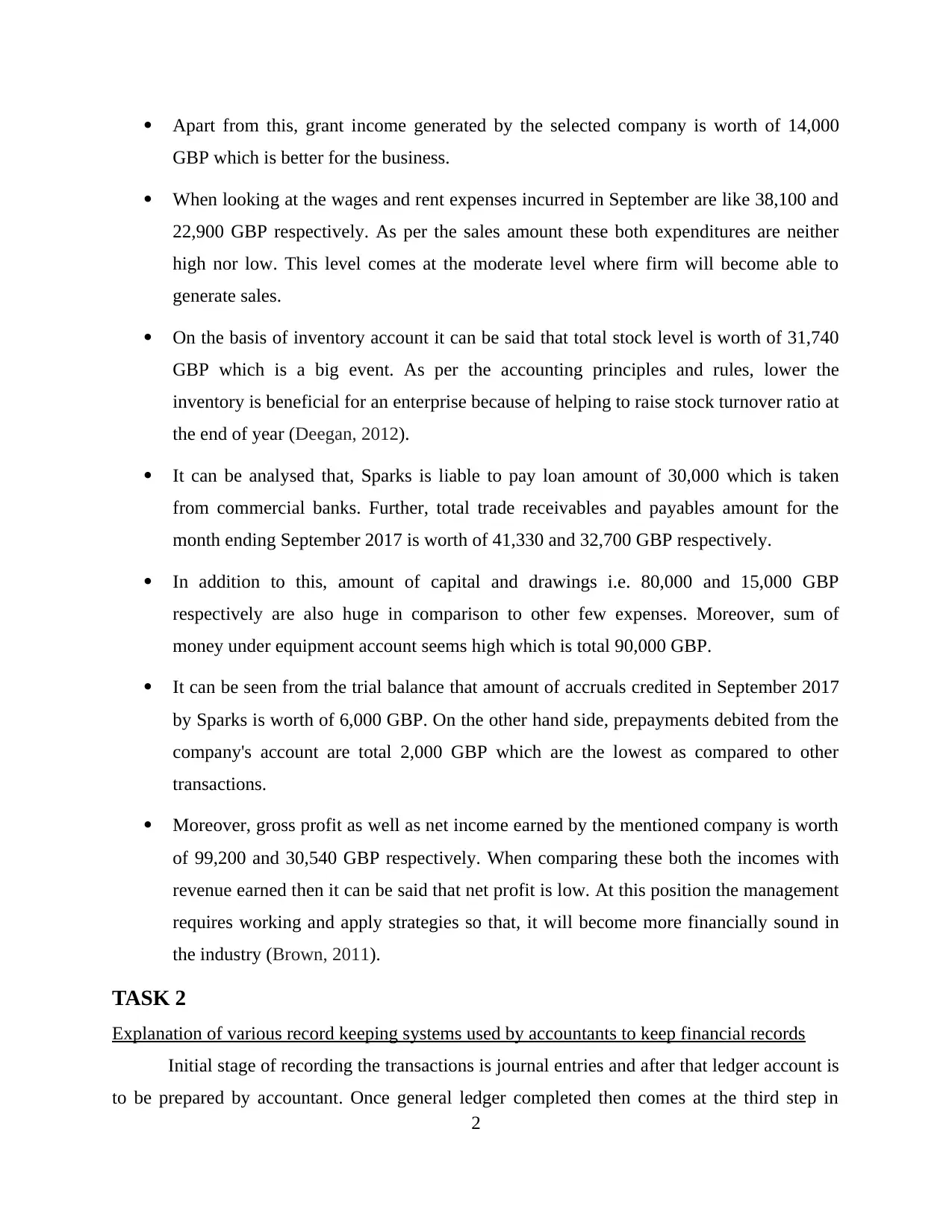
Apart from this, grant income generated by the selected company is worth of 14,000
GBP which is better for the business.
When looking at the wages and rent expenses incurred in September are like 38,100 and
22,900 GBP respectively. As per the sales amount these both expenditures are neither
high nor low. This level comes at the moderate level where firm will become able to
generate sales.
On the basis of inventory account it can be said that total stock level is worth of 31,740
GBP which is a big event. As per the accounting principles and rules, lower the
inventory is beneficial for an enterprise because of helping to raise stock turnover ratio at
the end of year (Deegan, 2012).
It can be analysed that, Sparks is liable to pay loan amount of 30,000 which is taken
from commercial banks. Further, total trade receivables and payables amount for the
month ending September 2017 is worth of 41,330 and 32,700 GBP respectively.
In addition to this, amount of capital and drawings i.e. 80,000 and 15,000 GBP
respectively are also huge in comparison to other few expenses. Moreover, sum of
money under equipment account seems high which is total 90,000 GBP.
It can be seen from the trial balance that amount of accruals credited in September 2017
by Sparks is worth of 6,000 GBP. On the other hand side, prepayments debited from the
company's account are total 2,000 GBP which are the lowest as compared to other
transactions.
Moreover, gross profit as well as net income earned by the mentioned company is worth
of 99,200 and 30,540 GBP respectively. When comparing these both the incomes with
revenue earned then it can be said that net profit is low. At this position the management
requires working and apply strategies so that, it will become more financially sound in
the industry (Brown, 2011).
TASK 2
Explanation of various record keeping systems used by accountants to keep financial records
Initial stage of recording the transactions is journal entries and after that ledger account is
to be prepared by accountant. Once general ledger completed then comes at the third step in
2
GBP which is better for the business.
When looking at the wages and rent expenses incurred in September are like 38,100 and
22,900 GBP respectively. As per the sales amount these both expenditures are neither
high nor low. This level comes at the moderate level where firm will become able to
generate sales.
On the basis of inventory account it can be said that total stock level is worth of 31,740
GBP which is a big event. As per the accounting principles and rules, lower the
inventory is beneficial for an enterprise because of helping to raise stock turnover ratio at
the end of year (Deegan, 2012).
It can be analysed that, Sparks is liable to pay loan amount of 30,000 which is taken
from commercial banks. Further, total trade receivables and payables amount for the
month ending September 2017 is worth of 41,330 and 32,700 GBP respectively.
In addition to this, amount of capital and drawings i.e. 80,000 and 15,000 GBP
respectively are also huge in comparison to other few expenses. Moreover, sum of
money under equipment account seems high which is total 90,000 GBP.
It can be seen from the trial balance that amount of accruals credited in September 2017
by Sparks is worth of 6,000 GBP. On the other hand side, prepayments debited from the
company's account are total 2,000 GBP which are the lowest as compared to other
transactions.
Moreover, gross profit as well as net income earned by the mentioned company is worth
of 99,200 and 30,540 GBP respectively. When comparing these both the incomes with
revenue earned then it can be said that net profit is low. At this position the management
requires working and apply strategies so that, it will become more financially sound in
the industry (Brown, 2011).
TASK 2
Explanation of various record keeping systems used by accountants to keep financial records
Initial stage of recording the transactions is journal entries and after that ledger account is
to be prepared by accountant. Once general ledger completed then comes at the third step in
2
Paraphrase This Document
Need a fresh take? Get an instant paraphrase of this document with our AI Paraphraser
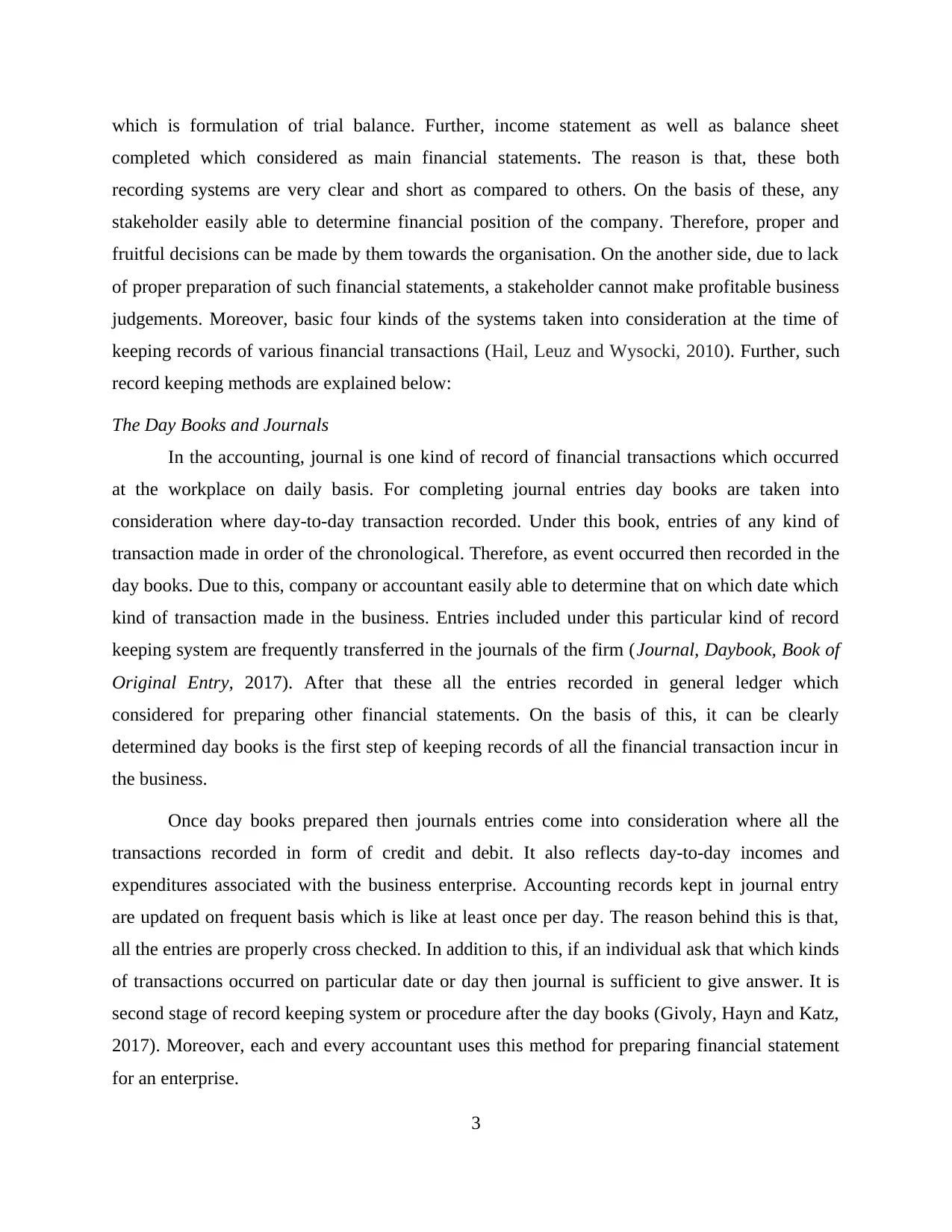
which is formulation of trial balance. Further, income statement as well as balance sheet
completed which considered as main financial statements. The reason is that, these both
recording systems are very clear and short as compared to others. On the basis of these, any
stakeholder easily able to determine financial position of the company. Therefore, proper and
fruitful decisions can be made by them towards the organisation. On the another side, due to lack
of proper preparation of such financial statements, a stakeholder cannot make profitable business
judgements. Moreover, basic four kinds of the systems taken into consideration at the time of
keeping records of various financial transactions (Hail, Leuz and Wysocki, 2010). Further, such
record keeping methods are explained below:
The Day Books and Journals
In the accounting, journal is one kind of record of financial transactions which occurred
at the workplace on daily basis. For completing journal entries day books are taken into
consideration where day-to-day transaction recorded. Under this book, entries of any kind of
transaction made in order of the chronological. Therefore, as event occurred then recorded in the
day books. Due to this, company or accountant easily able to determine that on which date which
kind of transaction made in the business. Entries included under this particular kind of record
keeping system are frequently transferred in the journals of the firm (Journal, Daybook, Book of
Original Entry, 2017). After that these all the entries recorded in general ledger which
considered for preparing other financial statements. On the basis of this, it can be clearly
determined day books is the first step of keeping records of all the financial transaction incur in
the business.
Once day books prepared then journals entries come into consideration where all the
transactions recorded in form of credit and debit. It also reflects day-to-day incomes and
expenditures associated with the business enterprise. Accounting records kept in journal entry
are updated on frequent basis which is like at least once per day. The reason behind this is that,
all the entries are properly cross checked. In addition to this, if an individual ask that which kinds
of transactions occurred on particular date or day then journal is sufficient to give answer. It is
second stage of record keeping system or procedure after the day books (Givoly, Hayn and Katz,
2017). Moreover, each and every accountant uses this method for preparing financial statement
for an enterprise.
3
completed which considered as main financial statements. The reason is that, these both
recording systems are very clear and short as compared to others. On the basis of these, any
stakeholder easily able to determine financial position of the company. Therefore, proper and
fruitful decisions can be made by them towards the organisation. On the another side, due to lack
of proper preparation of such financial statements, a stakeholder cannot make profitable business
judgements. Moreover, basic four kinds of the systems taken into consideration at the time of
keeping records of various financial transactions (Hail, Leuz and Wysocki, 2010). Further, such
record keeping methods are explained below:
The Day Books and Journals
In the accounting, journal is one kind of record of financial transactions which occurred
at the workplace on daily basis. For completing journal entries day books are taken into
consideration where day-to-day transaction recorded. Under this book, entries of any kind of
transaction made in order of the chronological. Therefore, as event occurred then recorded in the
day books. Due to this, company or accountant easily able to determine that on which date which
kind of transaction made in the business. Entries included under this particular kind of record
keeping system are frequently transferred in the journals of the firm (Journal, Daybook, Book of
Original Entry, 2017). After that these all the entries recorded in general ledger which
considered for preparing other financial statements. On the basis of this, it can be clearly
determined day books is the first step of keeping records of all the financial transaction incur in
the business.
Once day books prepared then journals entries come into consideration where all the
transactions recorded in form of credit and debit. It also reflects day-to-day incomes and
expenditures associated with the business enterprise. Accounting records kept in journal entry
are updated on frequent basis which is like at least once per day. The reason behind this is that,
all the entries are properly cross checked. In addition to this, if an individual ask that which kinds
of transactions occurred on particular date or day then journal is sufficient to give answer. It is
second stage of record keeping system or procedure after the day books (Givoly, Hayn and Katz,
2017). Moreover, each and every accountant uses this method for preparing financial statement
for an enterprise.
3
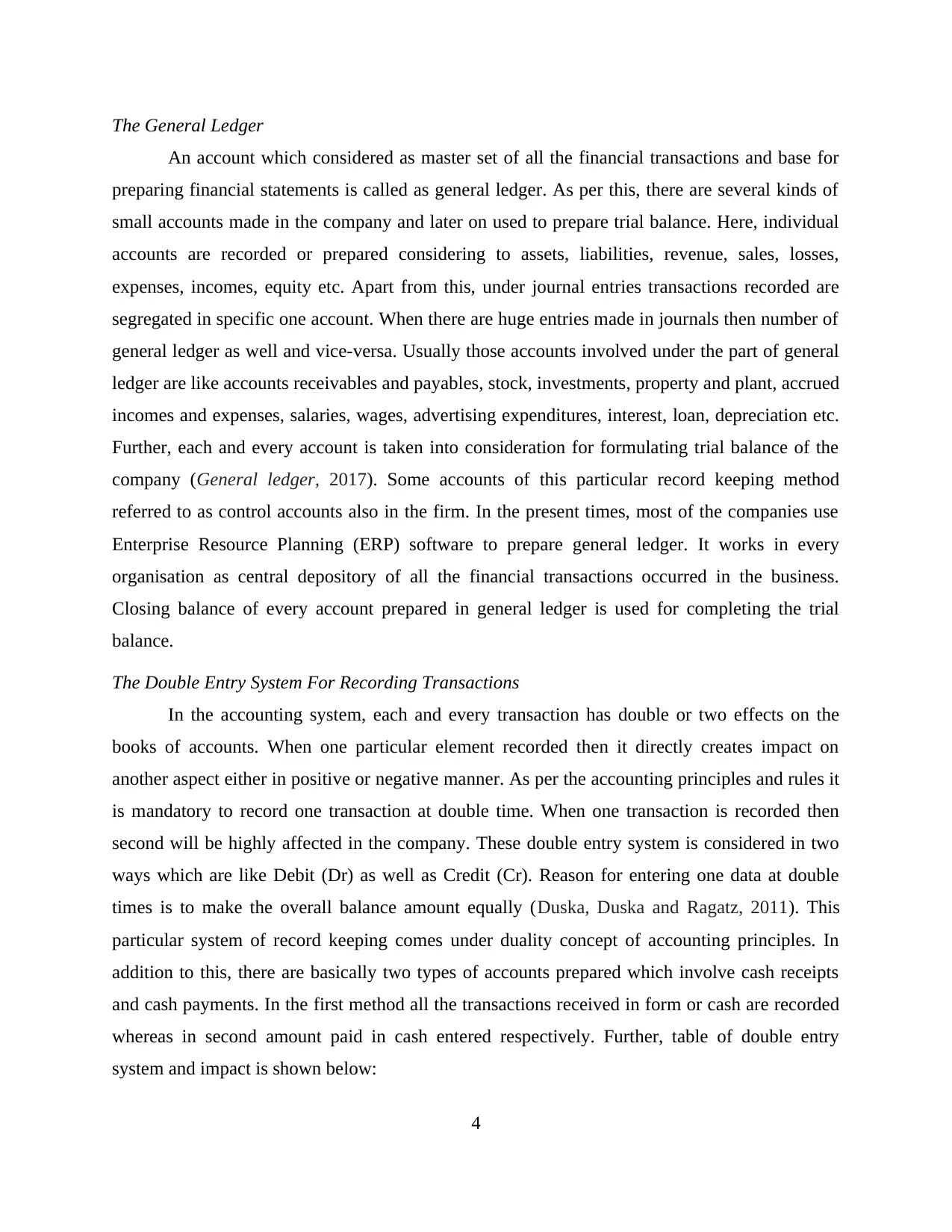
The General Ledger
An account which considered as master set of all the financial transactions and base for
preparing financial statements is called as general ledger. As per this, there are several kinds of
small accounts made in the company and later on used to prepare trial balance. Here, individual
accounts are recorded or prepared considering to assets, liabilities, revenue, sales, losses,
expenses, incomes, equity etc. Apart from this, under journal entries transactions recorded are
segregated in specific one account. When there are huge entries made in journals then number of
general ledger as well and vice-versa. Usually those accounts involved under the part of general
ledger are like accounts receivables and payables, stock, investments, property and plant, accrued
incomes and expenses, salaries, wages, advertising expenditures, interest, loan, depreciation etc.
Further, each and every account is taken into consideration for formulating trial balance of the
company (General ledger, 2017). Some accounts of this particular record keeping method
referred to as control accounts also in the firm. In the present times, most of the companies use
Enterprise Resource Planning (ERP) software to prepare general ledger. It works in every
organisation as central depository of all the financial transactions occurred in the business.
Closing balance of every account prepared in general ledger is used for completing the trial
balance.
The Double Entry System For Recording Transactions
In the accounting system, each and every transaction has double or two effects on the
books of accounts. When one particular element recorded then it directly creates impact on
another aspect either in positive or negative manner. As per the accounting principles and rules it
is mandatory to record one transaction at double time. When one transaction is recorded then
second will be highly affected in the company. These double entry system is considered in two
ways which are like Debit (Dr) as well as Credit (Cr). Reason for entering one data at double
times is to make the overall balance amount equally (Duska, Duska and Ragatz, 2011). This
particular system of record keeping comes under duality concept of accounting principles. In
addition to this, there are basically two types of accounts prepared which involve cash receipts
and cash payments. In the first method all the transactions received in form or cash are recorded
whereas in second amount paid in cash entered respectively. Further, table of double entry
system and impact is shown below:
4
An account which considered as master set of all the financial transactions and base for
preparing financial statements is called as general ledger. As per this, there are several kinds of
small accounts made in the company and later on used to prepare trial balance. Here, individual
accounts are recorded or prepared considering to assets, liabilities, revenue, sales, losses,
expenses, incomes, equity etc. Apart from this, under journal entries transactions recorded are
segregated in specific one account. When there are huge entries made in journals then number of
general ledger as well and vice-versa. Usually those accounts involved under the part of general
ledger are like accounts receivables and payables, stock, investments, property and plant, accrued
incomes and expenses, salaries, wages, advertising expenditures, interest, loan, depreciation etc.
Further, each and every account is taken into consideration for formulating trial balance of the
company (General ledger, 2017). Some accounts of this particular record keeping method
referred to as control accounts also in the firm. In the present times, most of the companies use
Enterprise Resource Planning (ERP) software to prepare general ledger. It works in every
organisation as central depository of all the financial transactions occurred in the business.
Closing balance of every account prepared in general ledger is used for completing the trial
balance.
The Double Entry System For Recording Transactions
In the accounting system, each and every transaction has double or two effects on the
books of accounts. When one particular element recorded then it directly creates impact on
another aspect either in positive or negative manner. As per the accounting principles and rules it
is mandatory to record one transaction at double time. When one transaction is recorded then
second will be highly affected in the company. These double entry system is considered in two
ways which are like Debit (Dr) as well as Credit (Cr). Reason for entering one data at double
times is to make the overall balance amount equally (Duska, Duska and Ragatz, 2011). This
particular system of record keeping comes under duality concept of accounting principles. In
addition to this, there are basically two types of accounts prepared which involve cash receipts
and cash payments. In the first method all the transactions received in form or cash are recorded
whereas in second amount paid in cash entered respectively. Further, table of double entry
system and impact is shown below:
4
⊘ This is a preview!⊘
Do you want full access?
Subscribe today to unlock all pages.

Trusted by 1+ million students worldwide

Accounting Element To Increase To Decrease
1. Asset Debit Credit
2. Liability Credit Debit
3. Capital investment Credit Debit
4. Capital withdrawal Debit Credit
5. Income Credit Debit
6. Expense Debit Credit
Trial Balance and Annual Reports
A report which run at the end of every financial year with recording ending or closing
balance of individual accounts is known as trial balance. In this system of financial transactions
record keeping debit amount of double entry is recorded in credit side. Apart from this, amount
of credit side is entered in debit side of trial balance of the company. Basic reason behind
preparing this particular account is to evaluated equality of debit and credit amounts (Uyar and
Gungormus, 2011). Moreover, it shows every information and data which used in order to
prepare final accounts for the firm. There is a condition that, debit and credit both amounts must
be equal in trial balance.
Annual report consists of main financial statements which are like I/S, B/S and cash
flows. For preparing these three accounts base of only trial balance is undertaken by accountant.
Cause behind this is that, it shows every transaction incurred at the workplace within whole
accounting period. Once these three statements completed then published along with disclosures
through annual report of the organisation.
TASK 3
Description of accruals concepts along with five examples of this particular concept
In order to make accounting treatments for preparing financial statements, some concepts
and principles of accounting are taken into consideration. The reason is that, these support to
5
1. Asset Debit Credit
2. Liability Credit Debit
3. Capital investment Credit Debit
4. Capital withdrawal Debit Credit
5. Income Credit Debit
6. Expense Debit Credit
Trial Balance and Annual Reports
A report which run at the end of every financial year with recording ending or closing
balance of individual accounts is known as trial balance. In this system of financial transactions
record keeping debit amount of double entry is recorded in credit side. Apart from this, amount
of credit side is entered in debit side of trial balance of the company. Basic reason behind
preparing this particular account is to evaluated equality of debit and credit amounts (Uyar and
Gungormus, 2011). Moreover, it shows every information and data which used in order to
prepare final accounts for the firm. There is a condition that, debit and credit both amounts must
be equal in trial balance.
Annual report consists of main financial statements which are like I/S, B/S and cash
flows. For preparing these three accounts base of only trial balance is undertaken by accountant.
Cause behind this is that, it shows every transaction incurred at the workplace within whole
accounting period. Once these three statements completed then published along with disclosures
through annual report of the organisation.
TASK 3
Description of accruals concepts along with five examples of this particular concept
In order to make accounting treatments for preparing financial statements, some concepts
and principles of accounting are taken into consideration. The reason is that, these support to
5
Paraphrase This Document
Need a fresh take? Get an instant paraphrase of this document with our AI Paraphraser
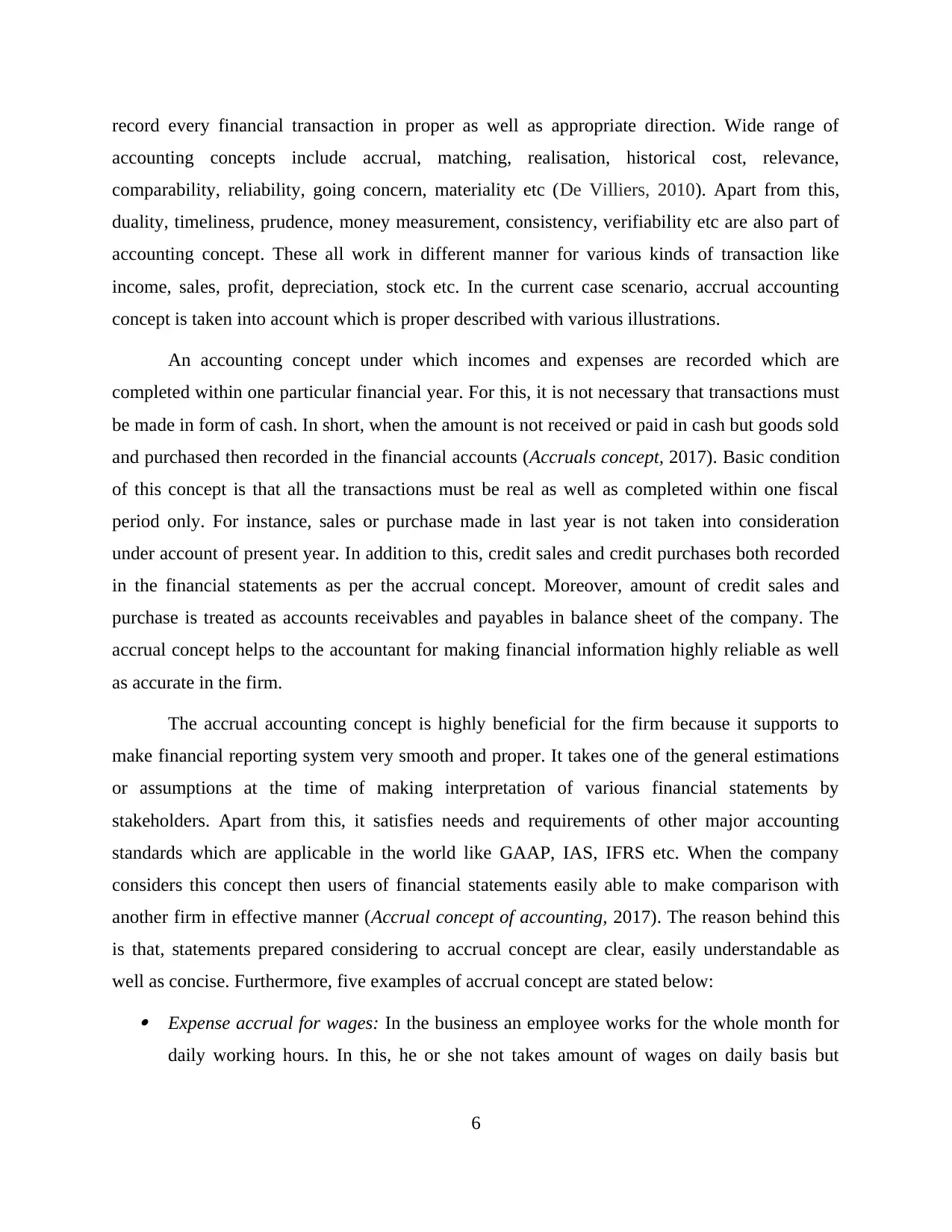
record every financial transaction in proper as well as appropriate direction. Wide range of
accounting concepts include accrual, matching, realisation, historical cost, relevance,
comparability, reliability, going concern, materiality etc (De Villiers, 2010). Apart from this,
duality, timeliness, prudence, money measurement, consistency, verifiability etc are also part of
accounting concept. These all work in different manner for various kinds of transaction like
income, sales, profit, depreciation, stock etc. In the current case scenario, accrual accounting
concept is taken into account which is proper described with various illustrations.
An accounting concept under which incomes and expenses are recorded which are
completed within one particular financial year. For this, it is not necessary that transactions must
be made in form of cash. In short, when the amount is not received or paid in cash but goods sold
and purchased then recorded in the financial accounts (Accruals concept, 2017). Basic condition
of this concept is that all the transactions must be real as well as completed within one fiscal
period only. For instance, sales or purchase made in last year is not taken into consideration
under account of present year. In addition to this, credit sales and credit purchases both recorded
in the financial statements as per the accrual concept. Moreover, amount of credit sales and
purchase is treated as accounts receivables and payables in balance sheet of the company. The
accrual concept helps to the accountant for making financial information highly reliable as well
as accurate in the firm.
The accrual accounting concept is highly beneficial for the firm because it supports to
make financial reporting system very smooth and proper. It takes one of the general estimations
or assumptions at the time of making interpretation of various financial statements by
stakeholders. Apart from this, it satisfies needs and requirements of other major accounting
standards which are applicable in the world like GAAP, IAS, IFRS etc. When the company
considers this concept then users of financial statements easily able to make comparison with
another firm in effective manner (Accrual concept of accounting, 2017). The reason behind this
is that, statements prepared considering to accrual concept are clear, easily understandable as
well as concise. Furthermore, five examples of accrual concept are stated below: Expense accrual for wages: In the business an employee works for the whole month for
daily working hours. In this, he or she not takes amount of wages on daily basis but
6
accounting concepts include accrual, matching, realisation, historical cost, relevance,
comparability, reliability, going concern, materiality etc (De Villiers, 2010). Apart from this,
duality, timeliness, prudence, money measurement, consistency, verifiability etc are also part of
accounting concept. These all work in different manner for various kinds of transaction like
income, sales, profit, depreciation, stock etc. In the current case scenario, accrual accounting
concept is taken into account which is proper described with various illustrations.
An accounting concept under which incomes and expenses are recorded which are
completed within one particular financial year. For this, it is not necessary that transactions must
be made in form of cash. In short, when the amount is not received or paid in cash but goods sold
and purchased then recorded in the financial accounts (Accruals concept, 2017). Basic condition
of this concept is that all the transactions must be real as well as completed within one fiscal
period only. For instance, sales or purchase made in last year is not taken into consideration
under account of present year. In addition to this, credit sales and credit purchases both recorded
in the financial statements as per the accrual concept. Moreover, amount of credit sales and
purchase is treated as accounts receivables and payables in balance sheet of the company. The
accrual concept helps to the accountant for making financial information highly reliable as well
as accurate in the firm.
The accrual accounting concept is highly beneficial for the firm because it supports to
make financial reporting system very smooth and proper. It takes one of the general estimations
or assumptions at the time of making interpretation of various financial statements by
stakeholders. Apart from this, it satisfies needs and requirements of other major accounting
standards which are applicable in the world like GAAP, IAS, IFRS etc. When the company
considers this concept then users of financial statements easily able to make comparison with
another firm in effective manner (Accrual concept of accounting, 2017). The reason behind this
is that, statements prepared considering to accrual concept are clear, easily understandable as
well as concise. Furthermore, five examples of accrual concept are stated below: Expense accrual for wages: In the business an employee works for the whole month for
daily working hours. In this, he or she not takes amount of wages on daily basis but
6
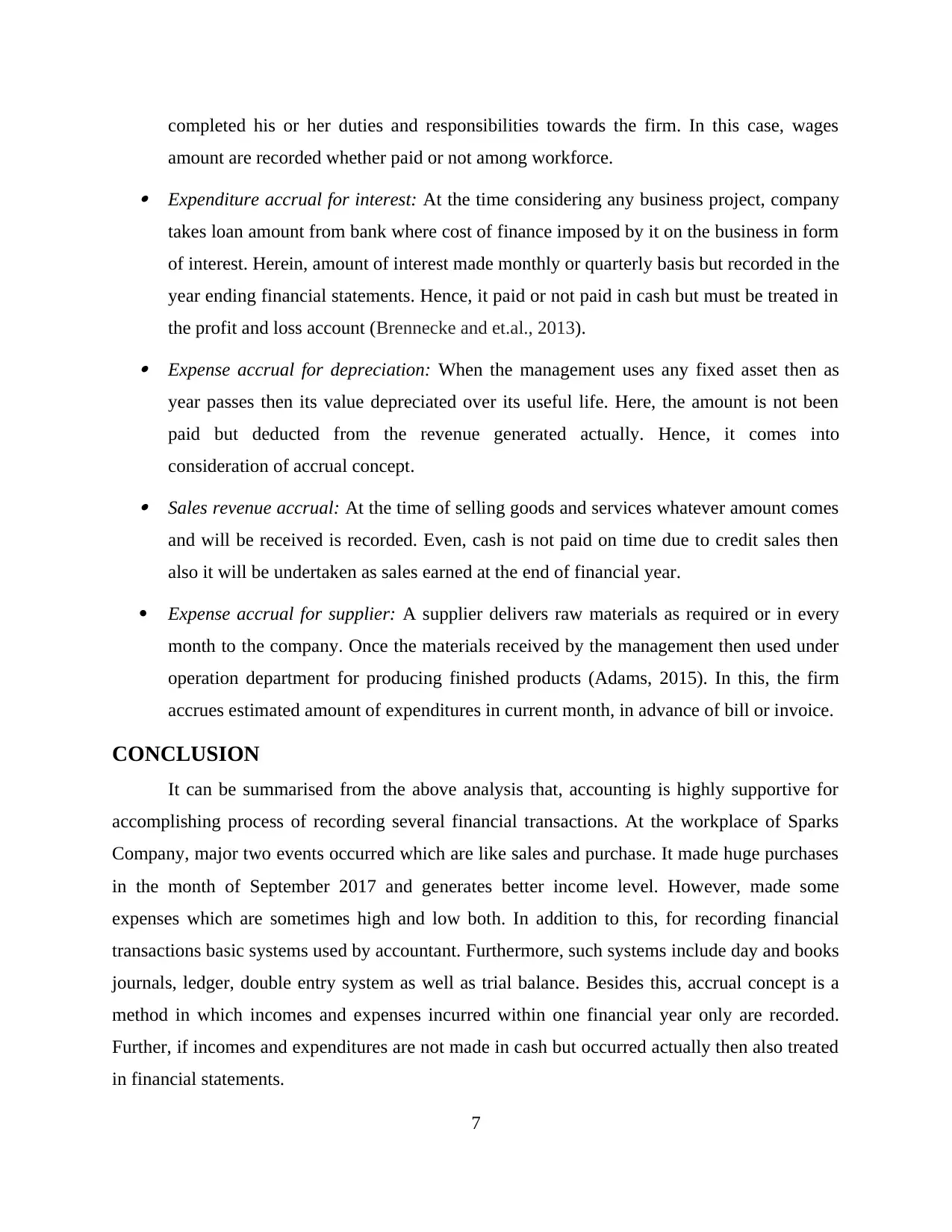
completed his or her duties and responsibilities towards the firm. In this case, wages
amount are recorded whether paid or not among workforce. Expenditure accrual for interest: At the time considering any business project, company
takes loan amount from bank where cost of finance imposed by it on the business in form
of interest. Herein, amount of interest made monthly or quarterly basis but recorded in the
year ending financial statements. Hence, it paid or not paid in cash but must be treated in
the profit and loss account (Brennecke and et.al., 2013). Expense accrual for depreciation: When the management uses any fixed asset then as
year passes then its value depreciated over its useful life. Here, the amount is not been
paid but deducted from the revenue generated actually. Hence, it comes into
consideration of accrual concept. Sales revenue accrual: At the time of selling goods and services whatever amount comes
and will be received is recorded. Even, cash is not paid on time due to credit sales then
also it will be undertaken as sales earned at the end of financial year.
Expense accrual for supplier: A supplier delivers raw materials as required or in every
month to the company. Once the materials received by the management then used under
operation department for producing finished products (Adams, 2015). In this, the firm
accrues estimated amount of expenditures in current month, in advance of bill or invoice.
CONCLUSION
It can be summarised from the above analysis that, accounting is highly supportive for
accomplishing process of recording several financial transactions. At the workplace of Sparks
Company, major two events occurred which are like sales and purchase. It made huge purchases
in the month of September 2017 and generates better income level. However, made some
expenses which are sometimes high and low both. In addition to this, for recording financial
transactions basic systems used by accountant. Furthermore, such systems include day and books
journals, ledger, double entry system as well as trial balance. Besides this, accrual concept is a
method in which incomes and expenses incurred within one financial year only are recorded.
Further, if incomes and expenditures are not made in cash but occurred actually then also treated
in financial statements.
7
amount are recorded whether paid or not among workforce. Expenditure accrual for interest: At the time considering any business project, company
takes loan amount from bank where cost of finance imposed by it on the business in form
of interest. Herein, amount of interest made monthly or quarterly basis but recorded in the
year ending financial statements. Hence, it paid or not paid in cash but must be treated in
the profit and loss account (Brennecke and et.al., 2013). Expense accrual for depreciation: When the management uses any fixed asset then as
year passes then its value depreciated over its useful life. Here, the amount is not been
paid but deducted from the revenue generated actually. Hence, it comes into
consideration of accrual concept. Sales revenue accrual: At the time of selling goods and services whatever amount comes
and will be received is recorded. Even, cash is not paid on time due to credit sales then
also it will be undertaken as sales earned at the end of financial year.
Expense accrual for supplier: A supplier delivers raw materials as required or in every
month to the company. Once the materials received by the management then used under
operation department for producing finished products (Adams, 2015). In this, the firm
accrues estimated amount of expenditures in current month, in advance of bill or invoice.
CONCLUSION
It can be summarised from the above analysis that, accounting is highly supportive for
accomplishing process of recording several financial transactions. At the workplace of Sparks
Company, major two events occurred which are like sales and purchase. It made huge purchases
in the month of September 2017 and generates better income level. However, made some
expenses which are sometimes high and low both. In addition to this, for recording financial
transactions basic systems used by accountant. Furthermore, such systems include day and books
journals, ledger, double entry system as well as trial balance. Besides this, accrual concept is a
method in which incomes and expenses incurred within one financial year only are recorded.
Further, if incomes and expenditures are not made in cash but occurred actually then also treated
in financial statements.
7
⊘ This is a preview!⊘
Do you want full access?
Subscribe today to unlock all pages.

Trusted by 1+ million students worldwide

8
Paraphrase This Document
Need a fresh take? Get an instant paraphrase of this document with our AI Paraphraser
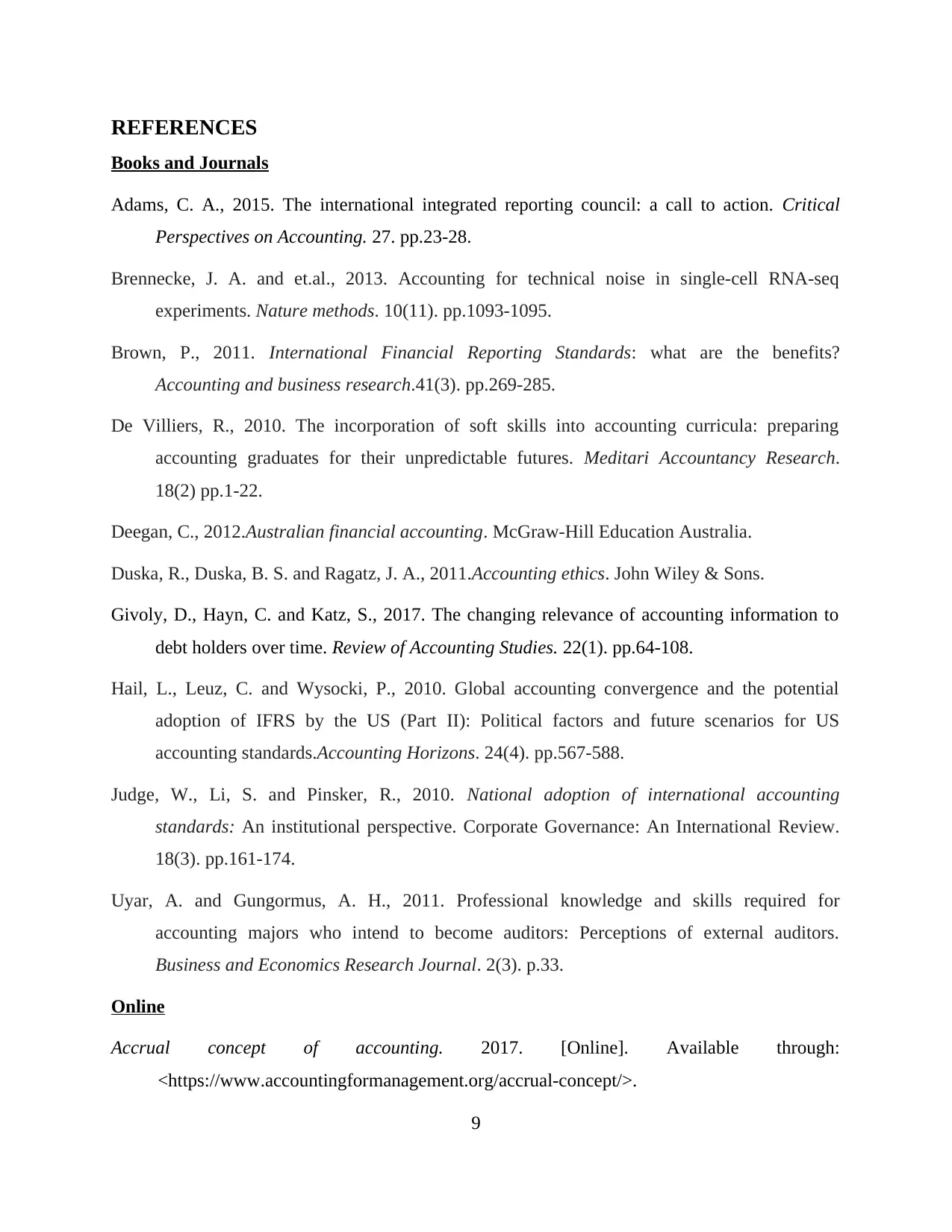
REFERENCES
Books and Journals
Adams, C. A., 2015. The international integrated reporting council: a call to action. Critical
Perspectives on Accounting. 27. pp.23-28.
Brennecke, J. A. and et.al., 2013. Accounting for technical noise in single-cell RNA-seq
experiments. Nature methods. 10(11). pp.1093-1095.
Brown, P., 2011. International Financial Reporting Standards: what are the benefits?
Accounting and business research.41(3). pp.269-285.
De Villiers, R., 2010. The incorporation of soft skills into accounting curricula: preparing
accounting graduates for their unpredictable futures. Meditari Accountancy Research.
18(2) pp.1-22.
Deegan, C., 2012.Australian financial accounting. McGraw-Hill Education Australia.
Duska, R., Duska, B. S. and Ragatz, J. A., 2011.Accounting ethics. John Wiley & Sons.
Givoly, D., Hayn, C. and Katz, S., 2017. The changing relevance of accounting information to
debt holders over time. Review of Accounting Studies. 22(1). pp.64-108.
Hail, L., Leuz, C. and Wysocki, P., 2010. Global accounting convergence and the potential
adoption of IFRS by the US (Part II): Political factors and future scenarios for US
accounting standards.Accounting Horizons. 24(4). pp.567-588.
Judge, W., Li, S. and Pinsker, R., 2010. National adoption of international accounting
standards: An institutional perspective. Corporate Governance: An International Review.
18(3). pp.161-174.
Uyar, A. and Gungormus, A. H., 2011. Professional knowledge and skills required for
accounting majors who intend to become auditors: Perceptions of external auditors.
Business and Economics Research Journal. 2(3). p.33.
Online
Accrual concept of accounting. 2017. [Online]. Available through:
<https://www.accountingformanagement.org/accrual-concept/>.
9
Books and Journals
Adams, C. A., 2015. The international integrated reporting council: a call to action. Critical
Perspectives on Accounting. 27. pp.23-28.
Brennecke, J. A. and et.al., 2013. Accounting for technical noise in single-cell RNA-seq
experiments. Nature methods. 10(11). pp.1093-1095.
Brown, P., 2011. International Financial Reporting Standards: what are the benefits?
Accounting and business research.41(3). pp.269-285.
De Villiers, R., 2010. The incorporation of soft skills into accounting curricula: preparing
accounting graduates for their unpredictable futures. Meditari Accountancy Research.
18(2) pp.1-22.
Deegan, C., 2012.Australian financial accounting. McGraw-Hill Education Australia.
Duska, R., Duska, B. S. and Ragatz, J. A., 2011.Accounting ethics. John Wiley & Sons.
Givoly, D., Hayn, C. and Katz, S., 2017. The changing relevance of accounting information to
debt holders over time. Review of Accounting Studies. 22(1). pp.64-108.
Hail, L., Leuz, C. and Wysocki, P., 2010. Global accounting convergence and the potential
adoption of IFRS by the US (Part II): Political factors and future scenarios for US
accounting standards.Accounting Horizons. 24(4). pp.567-588.
Judge, W., Li, S. and Pinsker, R., 2010. National adoption of international accounting
standards: An institutional perspective. Corporate Governance: An International Review.
18(3). pp.161-174.
Uyar, A. and Gungormus, A. H., 2011. Professional knowledge and skills required for
accounting majors who intend to become auditors: Perceptions of external auditors.
Business and Economics Research Journal. 2(3). p.33.
Online
Accrual concept of accounting. 2017. [Online]. Available through:
<https://www.accountingformanagement.org/accrual-concept/>.
9
1 out of 11
Related Documents
Your All-in-One AI-Powered Toolkit for Academic Success.
+13062052269
info@desklib.com
Available 24*7 on WhatsApp / Email
![[object Object]](/_next/static/media/star-bottom.7253800d.svg)
Unlock your academic potential
Copyright © 2020–2025 A2Z Services. All Rights Reserved. Developed and managed by ZUCOL.




